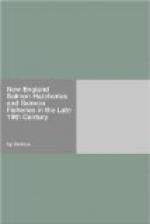There were never enough fish here before to make it worth while for them to drift for them. A few years ago no salmon were caught there at all. Twenty-two years ago, before our fish laws were enacted, the farmer at the Hunt place used to have a net that went entirely across the river clear to the bottom, which he kept all the time stretched across, and he only used to get two or three salmon a week. I was there August, 1857, with Mr. Joseph Carr, an old salmon fisher, and we fished for ten days and could not get a rise. The net had been taken up, because the farmer did not get fish enough to pay for looking after it.
But the stocking the river makes it good fishing and I intend to try the east branch next season with the fly.
Very truly,
Henry M. Prentiss.
* * * * * *
October 13, 1879
East Windsor Hill, Conn.
Professor Baird:
Dear sir: It may be of interest to you to know that your salmon are not all lost. Last Friday, 10th, I was with a party of three fishing in Snipsic Lake, and one of our party caught a salmon that weighed 1 3/4 pounds. This is the second one taken since the pond was stocked as I was told. The other was caught this summer and weighed 12 ounces.
Cannot something be done to save our fish in Connecticut River? There is an establishment at Holyoke, Mass., and another at Windsor Locks, Conn., that are manufacturing logs into paper, and I am told that the chemicals used for that purpose are let off into the river twice a day, and that the fish for half a mile come up as though they had been cockled.
Both of these factories are at the foot of falls where the fish collect and stop in great numbers and are all killed. Our shores and sand-bars are literally lined with dead fish. Three salmon have been found among them within two miles of my office. They were judged to weigh 12, 20 and 25 pounds. The dead fish are so numerous that eagles are here after them. I have received nine that have been shot here in the past two seasons.
I have written you in order that the fish commissioners might stop this nuisance and save the fish that they have taken so much pains to propagate.
Truly yours,
Wm Hood, East Windsor Hill, Conn., October 13, 1879
* * * * * *
Saint Stephen, March 1, 1880.
Prof. Spencer F. Baird
U. S. Commissioner Fish and Fisheries:
Dear Sir: I send you remarks in relation to the Restigouche and Saint Croix Rivers, which, though crude, I am sure are quite correct, as they are either taken from the official statistics, or are facts of which I am myself cognizant. You may, if of use, publish any part of them.




